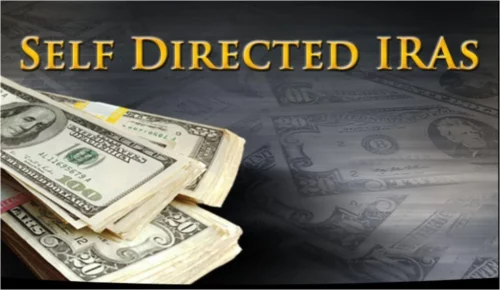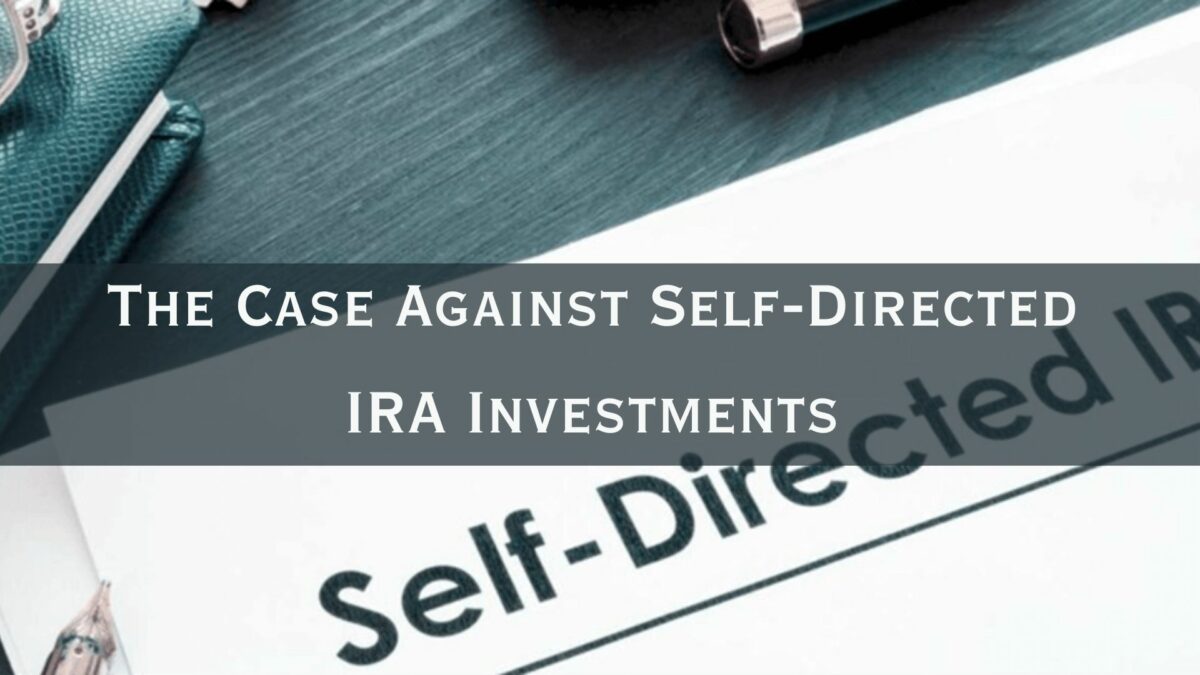“Happiness is being retired and spending all of my kids’ inheritance before I die!”
–Anonymous

If you remember in the 2012 Presidential debates, one surprising fact came up regarding Mitt Romney. He had something like $72 quadrillion dollars in his IRA. OK. He didn’t really have that much (it was $71 quadrillion), but he had a TON of money in there. It was much more than you and I would ever think of having in our IRAs investing in the usual stocks, bonds, and the like. People started doing the mental math of how much he could have possibly put into his IRA ($106,500) and how much he would have had to get in investment returns (a lot) to get to the point where he was.
The overly simplistic answer is that while Romney was at Bain Capital, he funded some of his projects using a self-directed individual retirement arrangement (IRA) (yup, most people think it’s an individual retirement account; they’re wrong).
I’ve briefly covered these before, in my interview with super CPA and attorney Mark Kohler. Most IRA accounts allow you to invest in plain vanilla investments – stocks, bonds, mutual funds, CDs, Treasuries, and the like. However, with a self-directed IRA, you’re allowed to open up the investment possibilities to a much broader class of investments.
Basically, as long as you fall within the management guidelines for an IRA, you can invest in anything outside of collectibles and life insurance. There are a few companies who specialize in setting up self-directed IRA limited liability companies whereby the custodian – the broker who holds the IRA – invests the money into the LLC which you then manage.
As long as you get the proper guidance and set everything up in accordance with the Internal Revenue Service’s requirements for keeping your IRA as an actual retirement account, then it’s not terribly difficult to accomplish, although the fees can add up very quickly if you choose the wrong custodian.
If you’re a small business owner or a fan of rental properties, then it seems like a pretty good idea to throw some of your investments into a self-directed IRA, right? If the company grows, the real estate appreciates, you get rent, and the like, you could have all of that growth tax deferred, or, if it’s a Roth IRA, tax free.
All of that is great if you plan on retiring at age 59 ½, when you can access your IRA funds without paying an early withdrawal penalty. If you have to withdraw funds from your traditional IRA before age 59 ½, then there are only a few ways of accomplishing it without incurring a 10% early withdrawal penalty.
First, you could have a hardship. These include disability, medical expenses above 7.5% of your AGI, or medical insurance premiums (if you’ve lost your job and receive unemployment compensation). You could pay for higher education. You can also withdraw $10,000 for the “first time” purchase of a home.
Another method of accessing your money is through a 72(t) distribution. This requires that you make a series of substantially equal periodic payment (SOSEPP). There are three ways you can make these payments:
- Using the Required Minimum Distribution (RMD) method. This requires you to divide your balance by a factor based on your age and withdraw that amount in the given year. The amount changes each year.
- Using the fixed amortization method. With this method, you determine your life expectancy based on actuarial tables and determine a fixed amount to take out each year.
- Using the fixed annuitization method. Using this method, you figure out, effectively, how much of an annuity your IRA balance could purchase and take out that amount each year. Again, you take out the same amount each year.
The Internal Revenue Service requires you to continue taking out those fixed payments for the greater of five years or the number of years required for you to reach age 59 ½ if you don’t want to pay the 10% early withdrawal penalty.
Here’s a nifty little SOSEPP calculator which shows you what your distributions might look like.
It’s not like your money is completely locked up if it’s all in an IRA, but you are limited to how much you can access and not pay the early withdrawal penalty.
How Will Having a Self-Directed IRA Affect You If You Retire Early?

Be honest – the reason you’d want to put an investment in a self-directed IRA is because you want it to go big. Build a company, sell it, and boom! Mad stacks.
I’ll do a small case here to illustrate why the self-directed IRA could create some hiccups with an early retirement strategy.
Let’s imagine that Bob (not his real name), a 30 year old married to a 28 year old wife, Roberta (not her real name), decided to start up Bob’s Widgets, Inc. in his garage making the best widgets in the world. He starts up the garage company at age 30 with a checkbook LLC in his self-directed IRA.
Fast forward ten years later. Bob gets an offer for his company for more than his apocalypse fund, and he gets $1.5 million for Bob’s Widgets, Inc.
Now, there’s a $1.5 million balance in Bob’s IRA. He’s unemployed, and since he just finished working his keyster off for the past 10 years to build his company and sell it, he’s ready to enjoy the good life. What are Bob’s options?
Using Bankrate’s nifty little calculator and a reasonable interest rate of 2.48% (this is based on federal interest rates for the previous two months), we see that Bob, using a joint life expectancy, can withdraw the following amounts:
| Method | Annual Withdrawal Amount |
| RMD | $29,240 |
| Fixed amortization method | $51,998 |
| Fixed annuitization method | $56,292 |
Depending on where he lived, the latter two amounts might be enough to live on. The fixed amortization method would give him $4,333.17 per month, and the fixed annuitization method would give him $4,691 per month. As a comparison, the RMD method would yield $2,436 per month.
The problem with choosing either of the latter two methodologies is that Bob and Roberta still have decades of inflation to deal with, and they can’t change how much they withdraw until Bob reaches 59 ½, two decades into the future. His account will probably continue to grow, but he can’t adjust the amount that he’s withdrawing to account for that account growth. Meanwhile, his purchasing power will be beaten senseless by inflation.
If he chooses the RMD method, he can increase the amount he withdraws each year, but the number he’ll start off with will be extremely paltry, particularly compared to his net worth. He’ll certainly not be able to retire on the initial RMD amounts unless he likes recycling soap shavings and making clothing out of dryer lint. It would be one heck of an act of cognitive dissonance to live such a sparse existence while sitting on one and a half meal tickets.
Meanwhile, if Bob hadn’t invested his startup equity through a self-directed IRA and had, instead, just owned the company outright, he’d have $1.2 million after paying a 20% long-term capital gains tax. It might not be enough to retire on, since a reasonably safe withdrawal rate of 3.5% would yield him $42,000 a year or $3,500 a month, but he’s not terribly far away from having enough to retire on. If he wanted to get to $4,375 a month – $52,500 annually – using the same withdrawal rate, he’d need to have $1.5 million – the original amount. His investment would have to grow an average of 4.6% for him to hit that target in five years. Plus, he’s going to have much more flexibility in how he manages, invests, and spends his money than he would if he would have had all of that money in his IRA. If his investments do well, then he can increase how much he withdraws. In a lean year, he could dial back a little to preserve capital – the basic nuts and bolts of withdrawal management strategies.
If you plan on working until at least age 59 ½, then, by all means, stuff your IRA any way you legally can. Feel free to put your small business ventures and real estate investments in a self-directed IRA after you get professional guidance on how to do so. The reason this approach will work is because you will not need to rely on your investment income to provide you with money to pay your day to day expenses until you stop working. You’ll have a salary to cover the costs of putting food on the table, a roof over your head, clothes on your body, and a way to move you from point A to point B that doesn’t require heavy foot power.
If you plan on needing to use your investment income to live on significantly before you turn age 59 ½, you could face a situation where you are retirement account rich and cash account poor if you have a significant portion of your net worth set aside in IRAs. If you plan on retiring early, please continue maxing out your IRA contributions; just consider when you’ll need that money before deciding to use a self-directed IRA to purchase non-traditional assets.
Have you used a self-directed IRA before? Were you happy you did it, or did you feel the income trap which I described above? Tell us about your experiences in the comments below!
Author Profile
- John Davis is a nationally recognized expert on credit reporting, credit scoring, and identity theft. He has written four books about his expertise in the field and has been featured extensively in numerous media outlets such as The Wall Street Journal, The Washington Post, CNN, CBS News, CNBC, Fox Business, and many more. With over 20 years of experience helping consumers understand their credit and identity protection rights, John is passionate about empowering people to take control of their finances. He works with financial institutions to develop consumer-friendly policies that promote financial literacy and responsible borrowing habits.
Latest entries
 Low Income GrantsSeptember 25, 2023How to Get a Free Government Phone: A Step-by-Step Guide
Low Income GrantsSeptember 25, 2023How to Get a Free Government Phone: A Step-by-Step Guide Low Income GrantsSeptember 25, 2023Dental Charities That Help With Dental Costs
Low Income GrantsSeptember 25, 2023Dental Charities That Help With Dental Costs Low Income GrantsSeptember 25, 2023Low-Cost Hearing Aids for Seniors: A Comprehensive Guide
Low Income GrantsSeptember 25, 2023Low-Cost Hearing Aids for Seniors: A Comprehensive Guide Low Income GrantsSeptember 25, 2023Second Chance Apartments that Accept Evictions: A Comprehensive Guide
Low Income GrantsSeptember 25, 2023Second Chance Apartments that Accept Evictions: A Comprehensive Guide

